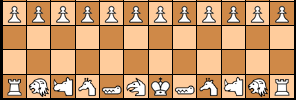[ List Latest Comments Only For Pages | Games | Rated Pages | Rated Games | Subjects of Discussion ]
Comments/Ratings for a Single Item
I was replying to Jörg Knappen's previous comment. Until I followed his link I knew nothing about the game either.
Charles Gilman wrote:
So how come this site doesn't have a Ko Shogi page?
AFAIK, it's because no one has made one.
Is it anything to do with the different piece names from most Shogi variants?
Unlikely. For my part, I never even heard of the game until you asked about it here.
Interesting to note that this game's players call the same piece by their word for elephant as Russians do by theirs!
I'm not clear on what you're talking about. Do you mean the Drunken Elephant? Does this have anything to do with the Honorable Horse?
So how come this site doesn't have a Ko Shogi page? Is it anything to do with the different piece names from most Shogi variants? Interesting to note that this game's players call the same piece by their word for elephant as Russians do by theirs! Returning to the subject in hand (until dropped, of course!), just as this is a modified Knight another piece is a Rook modified in the same way - but the original Rook is also there, in a new position.
I wouldn't say that the Knight was lost from Shogi. It just got modified to better fit the main feature of the game, which is dropping. Dropping a Chess Knight can be a powerful move, forking up to eight different pieces. This can also quickly reduce the clarity of the game. The Shogi Knight can fork only two pieces, which increases the clarity of the game, and makes holding a Knight in hand less of a threat to the other player. Also, since drops are allowed, a Knight that moves only forward is still useful, because a captured Knight can be dropped on spaces it wouldn't otherwise be able to reach.
I don't think that the rook 'reappeared' in Shogi, because it was never gone. Makruk, one antecessor in the genealogical line of Shogi, also has it. What is striking is that no widely played chess variant has lost the knight completely despite the fact that it is found difficult by many beginners and even intermediate level players of chess. The knight certainly adds 'flavour' to chess and to any chess variant where it is in. The rook is another constant in chess, being there from the very beginning.
Kō shōgi has reintroduced the classical knight (but since it was invented in the 18th century its inventor may have known the Orthochess knight) and also features two kinds of knight-based Lion-movers. The Cavalry 騎総 kisō must keep the longer direction of the knight move for its second move. The Winged horse 天馬 temba has a full double-knight Lion move.
Formidable pieces, I say.
Perhaps it is just by coincidence that the Rook reappeared. It really is an easy piece to invent, something that slides vertically or horizontally. On the other hand, the L-shaped Knight's move is a bit of an oddity. However, it is possible that someone could have generalized the Keima's move to go in all eight directions.
Given that the Rook 'reappeared' in Shogi, albeit singly rather than in pairs, it is perhaps surprising that the Knight didn't - except in the variant where one player has two Knights instead of six standard Shogi pieces.
There is one thing in classic Shogi variants, wich amazes me: among hundrends of pieces, there is only two pieces, wich have knight moves: this and Heavenly horse ( only in Wa Shogi), wich have also respective backward moves of Honourable horse! Of course, there is some pieces, wich technicaly can leap as knight (e.g.: Lion), but these moves just logicaly comes after common description of thier moves. For europeans it looks unbelievable, there is some piece with knight move or some it's variant almost in any variant of European chess! Note: possible, there is some other pieces with kinght's move in Taikyoku Shogi, i did not read it's description (if you know, what is Taikyoku Shogi, you know, why i did not read it's description).
10 comments displayed
Permalink to the exact comments currently displayed.
